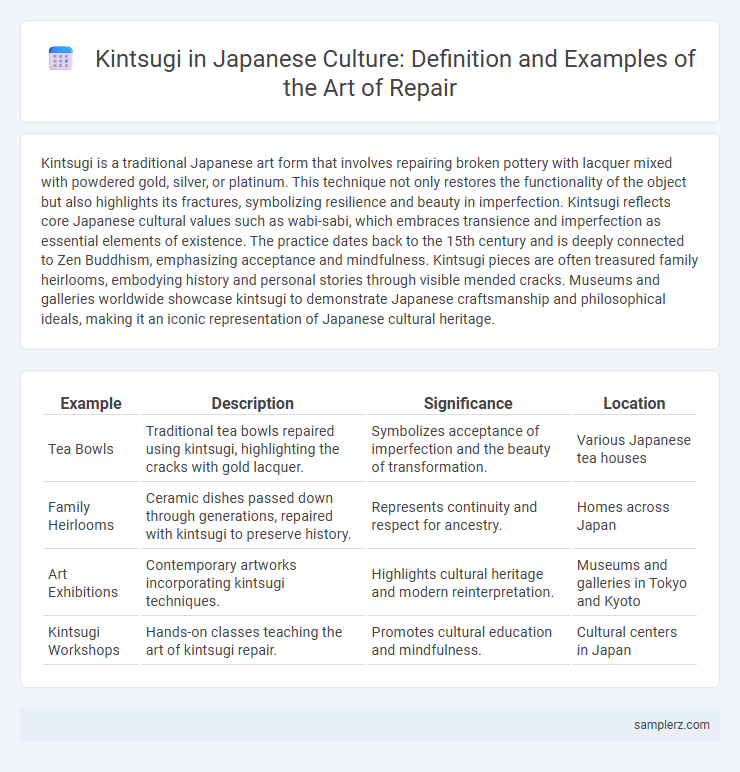Kintsugi is a traditional Japanese art form that involves repairing broken pottery with lacquer mixed with powdered gold, silver, or platinum. This technique not only restores the functionality of the object but also highlights its fractures, symbolizing resilience and beauty in imperfection. Kintsugi reflects core Japanese cultural values such as wabi-sabi, which embraces transience and imperfection as essential elements of existence. The practice dates back to the 15th century and is deeply connected to Zen Buddhism, emphasizing acceptance and mindfulness. Kintsugi pieces are often treasured family heirlooms, embodying history and personal stories through visible mended cracks. Museums and galleries worldwide showcase kintsugi to demonstrate Japanese craftsmanship and philosophical ideals, making it an iconic representation of Japanese cultural heritage.
Table of Comparison
| Example | Description | Significance | Location |
|---|---|---|---|
| Tea Bowls | Traditional tea bowls repaired using kintsugi, highlighting the cracks with gold lacquer. | Symbolizes acceptance of imperfection and the beauty of transformation. | Various Japanese tea houses |
| Family Heirlooms | Ceramic dishes passed down through generations, repaired with kintsugi to preserve history. | Represents continuity and respect for ancestry. | Homes across Japan |
| Art Exhibitions | Contemporary artworks incorporating kintsugi techniques. | Highlights cultural heritage and modern reinterpretation. | Museums and galleries in Tokyo and Kyoto |
| Kintsugi Workshops | Hands-on classes teaching the art of kintsugi repair. | Promotes cultural education and mindfulness. | Cultural centers in Japan |
The Art of Kintsugi: Embracing Imperfection in Japanese Culture
Kintsugi, the Japanese art of repairing broken pottery with gold lacquer, symbolizes the beauty of imperfection and the value of resilience in Japanese culture. This practice transforms damaged objects into unique works of art, highlighting flaws rather than hiding them, and embodies the philosophy of wabi-sabi, which finds beauty in transience and imperfection. Kintsugi reflects a deep cultural acceptance of change and the history embedded in objects, celebrating healing and the passage of time.
Historical Origins of Kintsugi: From Feudal Japan to Modern Times
Kintsugi, the Japanese art of repairing broken pottery with lacquer mixed with powdered gold, silver, or platinum, originated during the late 15th century in feudal Japan. This technique emerged as a reflection of the Japanese philosophy of wabi-sabi, emphasizing beauty in imperfection and impermanence. Over centuries, kintsugi evolved from a practical repair method into a celebrated art form symbolizing resilience and the passage of time.
Philosophical Foundations: Wabi-Sabi and the Spirit of Kintsugi
Kintsugi embodies the Japanese philosophy of Wabi-Sabi, which finds beauty in imperfection and transience by highlighting cracks and repairs instead of concealing them. This art reflects a profound acceptance of aging and damage, embracing flaws as unique history and value within an object. The spirit of Kintsugi teaches resilience and renewal, transforming broken pottery into a symbol of strength and continuous life.
Kintsugi Techniques: Traditional Methods and Materials Used
Kintsugi, the Japanese art of repairing broken pottery, employs traditional techniques using urushi lacquer mixed with powdered gold, silver, or platinum to highlight fractures rather than conceal them. Artisans meticulously apply multiple layers of lacquer to bond shards, followed by polishing to enhance the metallic veins, creating a unique blend of repair and beauty. This method not only restores functionality but also embodies the philosophy of embracing imperfection, making each piece a testament to resilience and history.
Symbolic Meaning: Healing, Resilience, and Transformation
Kintsugi, the Japanese art of repairing broken pottery with lacquer mixed with gold, symbolizes healing by embracing flaws rather than hiding them. This technique represents resilience, highlighting the strength found in recovery and the beauty that emerges from imperfection. It embodies transformation, as damaged objects are reborn with enhanced aesthetic and emotional value, reflecting a philosophy of acceptance and renewal.
Famous Kintsugi Artworks and Notable Examples in Japan
Famous kintsugi artworks such as the Ashiya ware tea bowls and the Tsugaru lacquerware exemplify the intricate beauty of this Japanese repairing technique. The golden seams of these masterpieces highlight the philosophy of embracing flaws, transforming broken ceramics into valuable cultural artifacts. Notable examples housed in institutions like the Tokyo National Museum illustrate the enduring significance of kintsugi in Japanese heritage.
Kintsugi Beyond Pottery: Applications in Contemporary Japanese Design
Kintsugi, the traditional Japanese art of repairing broken pottery with lacquer mixed with powdered gold, silver, or platinum, extends its philosophy into contemporary Japanese design by emphasizing beauty in imperfection and the value of restoration. Modern designers incorporate kintsugi principles into fashion, architecture, and product design to celebrate flaws as unique character rather than defects. This approach reflects Japan's cultural reverence for resilience and sustainability, aligning with broader trends in eco-conscious design and mindful consumption.
The Influence of Kintsugi on Modern Japanese Art and Fashion
Kintsugi, the traditional Japanese art of repairing broken pottery with gold, profoundly influences modern Japanese art and fashion by emphasizing beauty in imperfection and resilience. Contemporary designers incorporate kintsugi-inspired motifs and techniques into textiles and accessories, symbolizing renewal and uniqueness. This aesthetic philosophy resonates through modern visual arts and fashion collections, reinforcing cultural identity and innovative craftsmanship.
Kintsugi Workshops and Experiences: Where to Learn in Japan
Kintsugi workshops in Japan offer hands-on experiences where participants learn the traditional art of repairing pottery with gold lacquer, emphasizing beauty in imperfection. Popular locations include Tokyo's famed Kintsugi studios and Kanazawa's cultural centers, both providing expert guidance on this iconic Japanese craft. Engaging in these workshops allows visitors to connect deeply with Japan's cultural philosophy and master the delicate technique firsthand.
Kintsugi as a Metaphor: Life Lessons and Personal Growth
Kintsugi, the Japanese art of repairing broken pottery with gold lacquer, symbolizes resilience and the beauty of imperfection, teaching that flaws and damage can enhance value rather than diminish it. This metaphor encourages embracing life's challenges and failures as opportunities for personal growth and transformation, fostering a mindset of acceptance and renewal. Through kintsugi, individuals learn to honor their own scars and experiences, cultivating strength and inner beauty that emerge from adversity.

example of kintsugi in Japan Infographic
 samplerz.com
samplerz.com